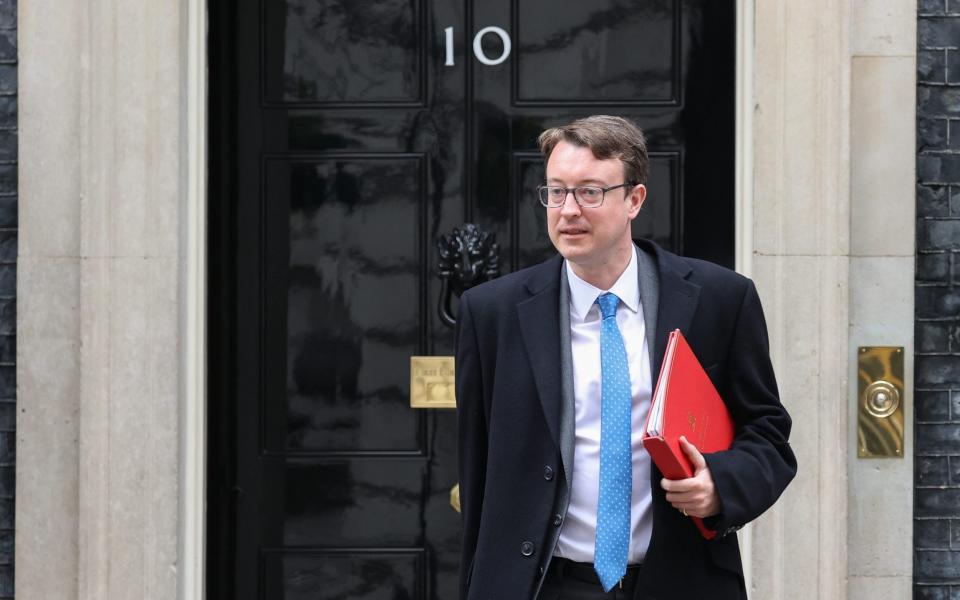Up to 40,000 civil service jobs face the axe

Thousands of civil service jobs created to tackle the pandemic and Brexit face the axe as the Treasury attempts to rein in soaring Whitehall headcounts.
Plans to slash as many as 40,000 roles will focus on cutting pandemic-related staff in the Department of Health and workers no longer needed after Brexit, The Telegraph can reveal.
The push comes as unions are warned by ministers to expect a new attempt to slash civil service exit payments as they prepare to cut the public payroll.
The number of civil servants has jumped by more than a fifth to 485,000 in the past seven years in response to Covid and Brexit, but the two policy challenges are beginning to recede.
“Those are the areas where we’re looking to reduce headcount,” said a government source.
The cutbacks will affect staff working on the “bureaucratic aspects” of the responses, rather than frontline staff, the insider stressed.
Dave Penman, general secretary of the FDA, said ministers had indicated to the civil service union that they would also revisit a clampdown on redundancy payments that could reduce them from a month’s pay for every year of service to three weeks.
Simon Clarke, Chief Secretary to the Treasury, said last month that the Government plans to get civil service headcount back to 2019/20 levels by 2024/25, equivalent to a 40,000 cut in roles.

He also signalled that ministers eventually want to go further, slashing the headcount back to 2015/16 levels, which would be a reduction of as many as 70,000 roles.
Mr Clarke said last month that increases in civil service headcount had become “impossible to justify long-term and something we’re determined to reverse”. Recent increases to the headcount have completely reversed the cuts during the austerity era.
In a speech setting out plans for a slimmed-down Whitehall, he said: “Through a scrupulous focus on efficiencies, more streamlined processes, and a better matching of our people to our priorities, we will bring civil service headcount down to sustainable levels for the longer term, and this will be a focus of the years leading up to the next Spending Review.”
However, the FDA warns many of the roles will be difficult to reverse given Covid backlogs and that power has permanently moved from Brussels after Brexit.
“A lot of health staff were brought in to deal with Covid and now you’ve got the legacy of it,” Mr Penman said, highlighting backlogs in health and the courts.
“What’s quite disappointing about some of the stuff that Rees-Mogg and Clarke were saying is they are fixating on this number of civil servants that have increased over the last five or six years and really that’s because the demands of the civil service have increased.”
The Government wants to move 22,000 civil servants out of London by 2030.
However, the expansion in recent years was largely concentrated in London as more staff were taken on to help with policy.
The disproportionate increases in the capital came despite promises by ministers to move decision makers out of London as part of the levelling-up drive.
Whitehall faces radical shake-up as minister promises a 'quiet revolution'
By Tom Rees
Whitehall mandarins could be forgiven for feeling a bit more secure after the sudden departure of Dominic Cummings from the heart of Government.
The Prime Minister’s former chief adviser had an overhaul of the civil service firmly in his sights after dubbing the bureaucracy “an idea for history books” and calling for its permanent secretaries to be scrapped.
“What SW1 needs is not more drivel about ‘identity’ and ‘diversity’ from Oxbridge humanities graduates but more genuine cognitive diversity,” he said in one of many diatribes launched against mandarins before leaving in November 2020.
But while the threat of a Cummings-led upheaval has vanished, the idea of a sweeping shake-up in Whitehall has outlived the adviser’s reign in Number 10.
Treasury number two minister Simon Clarke is promising a “quiet revolution” in Whitehall, after Michael Gove last year launched plans to reform the running of Government. As civil servants face a rude awakening after a huge expansion in headcount, a London-based lifestyle and years of homeworking, there are worries the upheaval might damage the flow of Government operations.
Speaking at the small state think tank the Institute of Economic Affairs late last month, Clarke outlined his ambitions to trim the fat off the state and return civil service numbers to pre-Covid and even pre-Brexit levels.
The chief secretary to the Treasury promised to sell off more Whitehall properties, clamp down on hefty exit payments for departing mandarins and reduce headcount, warning that Government spending has now reached a “high-water mark” and would not increase any further.
Ministers have also put huge pressure on civil servants to end working from home despite officials privately telling the Telegraph there are not enough desks for all Whitehall mandarins in some departments, such as health.
“The civil service headcount is up 23pc from 2015/16, and by almost 7pc in 2021 alone, something that’s impossible to justify long-term, and something we’re determined to reverse,” said Clarke.
“As a starting point, Government will ensure that resource is focused on delivering frontline services and cutting bureaucracy by reducing non-frontline civil service headcount to 2019/20 levels by 2024/25.”
After declining by around a fifth during the austerity era, civil service numbers have almost completely returned to previous levels over the last five years, reaching 485,000 in 2021.
Reversing the additional staff added since 2015 would mean as many as 70,000 job losses. Some doubt the Treasury can pull this off without disrupting the smooth running of Government, warning that many of the policy challenges of the pandemic and Brexit that prompted staff expansion will linger – and need staff.
“The civil service grow in response to the health pressures and the economic pressures of the pandemic,” says Rhys Clyne, an expert at the Institute for Government (IfG).
As the civil service has ballooned since Covid, so has the size of the state with public spending as a share of GDP expected to soar to its highest sustained level since the late 1970s.
“We've seen quite a sharp increase in the number of officials working on policy,” adds Clyne. “That's in response to these sort of unforeseen events and the throwing up of new policy demands and pressures on departments. You also see that therefore play out in where the civil servants are located.”
Added staff have also been concentrated in London at a time when Whitehall are trying to move decision makers out of the capital as part of its levelling up drive.
“The Government is absolutely right to focus on streamlining the civil service and reducing the overall headcount, which has ballooned during both Brexit and Covid,” says Will Tanner, director of think tank Onward.
“A lot of the growth in headcount has been concentrated in Whitehall. So if the Government is serious about levelling up and about reshaping the economic geography of the UK, they need to be doing the same thing.”
Doing this would reap benefits of cheaper staff and buildings outside London, argues Tanner, while also boosting the local economies that civil servants move to.
When it comes to where cuts will be, a Government source says ministers will focus on reducing headcount in the health department and among Brexit-related staff. They stress it will be the “bureaucratic aspects” of the departments that are cut, not frontline staff as ministers commit to more nurses.
The health department has seen a 40pc, or 3,740 person, increase in its headcount since the pandemic struck, the largest proportionally in Whitehall, according to the IfG. It says the trade department, meanwhile, has seen the biggest proportional increase since Brexit at close to a 200pc jump as it forged new trade deals.
“Governments expand and contract all the time,” says Dave Penman, general secretary of the FDA, the union for civil servants. “But it's whether they match the resources they give the civil service with what it’s committed to do.
Penman says it is “disappointing” that Clarke has been “fixating on this number of civil servants that have increased over the last five or six years and really that’s because the demands of the civil service have increased.”
He questions how much of the headcount can be effectively reversed, particularly given the backlogs in public services after Covid such as health and criminal cases.
While many of the pandemic hires may be able to be eventually reversed if the pandemic goes into permanent retreat, the Brexit-related recruitments could be more difficult to unwind as decisions on everything from trade to agriculture are moved from Brussels.
The EU was in charge of trade policy prior to Brexit, for instance, but now Britain is striking its own deals with the likes of India and the Gulf countries. The most ambitious and economically impactful, such as with the US, could take years to reach.
Clarke will likely be able to make some reductions to the number of mandarins as the pandemic recedes. But a period of policy calm may be needed before deeper cuts in Whitehall are made.
